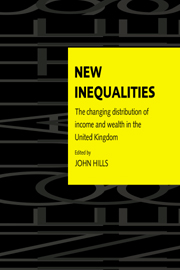Book contents
- Frontmatter
- Contents
- List of figures
- List of tables
- List of contributors
- Acknowledgements
- 1 Introduction: after the turning point
- Part I Income distribution
- 2 Seeking to explain the distribution of income
- 3 The changing shape of the UK income distribution: kernel density estimates
- 4 UK household cost-of-living indices, 1979–92
- 5 Cost-of-living differences between the regions of the United Kingdom
- Part II Components of income
- Part III Spatial aspects
- Part IV Income and wealth
- Bibliography
- Index
4 - UK household cost-of-living indices, 1979–92
from Part I - Income distribution
Published online by Cambridge University Press: 22 September 2009
- Frontmatter
- Contents
- List of figures
- List of tables
- List of contributors
- Acknowledgements
- 1 Introduction: after the turning point
- Part I Income distribution
- 2 Seeking to explain the distribution of income
- 3 The changing shape of the UK income distribution: kernel density estimates
- 4 UK household cost-of-living indices, 1979–92
- 5 Cost-of-living differences between the regions of the United Kingdom
- Part II Components of income
- Part III Spatial aspects
- Part IV Income and wealth
- Bibliography
- Index
Summary
Introduction
The only circumstance under which one can speak accurately about the cost-of-living index is one in which household expenditure patterns do not vary. If relative prices move and households consume goods and services in different proportions, then each household will have its own unique cost-of-living index. This chapter concerns the pattern and extent of these variations in the cost-of-living between different types of household.
To illustrate this, consider the data on a typical necessity: domestic fuels. Figure 4.1 shows the Engel curve for domestic fuel drawn non-parametrically using UK data from the 1992 Family Expenditure Survey (FES). The fuel share of total spending declines as the logarithm of total expenditure increases. This downward-sloping Engel curve is typical of goods that are usually thought of as necessities; poorer households with lower total expenditure spend a greater proportion of that total on necessities like fuel and food than do richer households.
Figure 4.2 shows the price of domestic fuels relative to the all-item retail price index from 1978 to 1992. Figures 4.1 and 4.2 are sufficient to show the existence of systematic differences between the cost-of-living of different households. The relative price movements illustrated will have a greater effect on the cost-of-living of households which consume more fuel than others. Banks, Blundell and Lewbel (1994) show that Engel curves are neither flat nor always linear for a range of commodities using UK FES data.
- Type
- Chapter
- Information
- New InequalitiesThe Changing Distribution of Income and Wealth in the United Kingdom, pp. 76 - 102Publisher: Cambridge University PressPrint publication year: 1996
- 6
- Cited by



